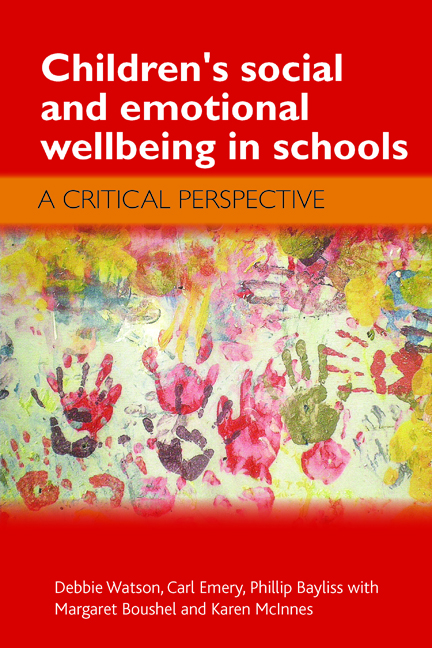Chapter 8 - Children’s peer relationships in schools
Published online by Cambridge University Press: 01 September 2022
Summary
Introduction
In this chapter, we consider a range of approaches to address children's difficulties in their peer relations in schools. In particular, we voice criticism of teaching conflict resolution (CR) skills to schoolchildren. We do so not because we do not share CR practitioners’ hopes of harmonious and enriching school environments, but in order to examine whether evidence demonstrates the effectiveness of this approach, and to explore and deconstruct the methods of CR in schools to see what unintended consequences and hidden agendas may be in play in regard to wellbeing. ‘Conflict resolution’ is a broad term and, like ‘wellbeing’, a contested concept (Isenhart and Spangle, 2000). According to Cohen (1995, p 15) ‘conflict is a discord of needs, drives, wishes, and/or demands’. Mack and Snyder stated that conflict ‘is for the most part a rubber concept, being stretched and moulded for the purposes at hand’ (Mack and Snyder, 1957, p 212). This quote applies also to ‘wellbeing’.
Less contested is the recognition that conflict can be intrapersonal (within the individual), interpersonal (between two parties) or intergroup (between groups) (Cohen, 1995), and that it has both a conceptual (internal/psychological) and a behavioural (external/activity) property (Sellman, 2003). In schools, CR is built on a social learning model (Groebel and Hinde, 1989; Bandura, 1997) according to which techniques for resolving conflicts can be learnt, and modelling influences behaviour, as does the environment. The idea that CR skills are readily learnable fits comfortably with Goleman's (1995) model of emotional intelligence, which is the foundation for the Social and Emotional Aspects of Learning (SEAL) programme and much of the social and emotional wellbeing (SEWB) practice delivered in UK schools. CR skills are taught in schools, generally by external training organisations, to support pupils in peacefully resolving conflicts in school and to develop an understanding of its causes and impact.
Most school-based CR practice sees conflict as a natural part of everyday school experience (Tyler, 1998). However, school CR rarely includes consideration of societal structures, class relationships or cultural forces (Sellman, 2003). Like much of the social and emotional learning agenda (see Chapters 4 and 5), school CR sees the locus of control as individuals in relationship with others. In this chapter, we consider three types of school CR and relate them to the school wellbeing agenda: peer mediation (including buddying); anti-bullying initiatives; and restorative approaches (RA).
- Type
- Chapter
- Information
- Children's Social and Emotional Wellbeing in SchoolsA Critical Perspective, pp. 125 - 142Publisher: Bristol University PressPrint publication year: 2012

